Table of Contents
Walking is a fundamental activity. It allows you to get around and maintain your overall health. But what happens when you experience lower leg pain when walking? Muscle strain and repetitive exercises are common culprits. However, leg pain can also be a sign of an underlying vascular condition.
In this post, you’ll learn about the seven reasons your legs might hurt when you walk. We’ll explain some of the common causes, the symptoms of each cause, and how they are generally treated.
7 causes of pain in the lower leg when walking
Leg pain can be a signal of many different underlying issues. Understanding the potential reasons for your pain makes it easier to get the right kind of help when you need it. Here’s a look at the common causes of lower leg pain when walking.
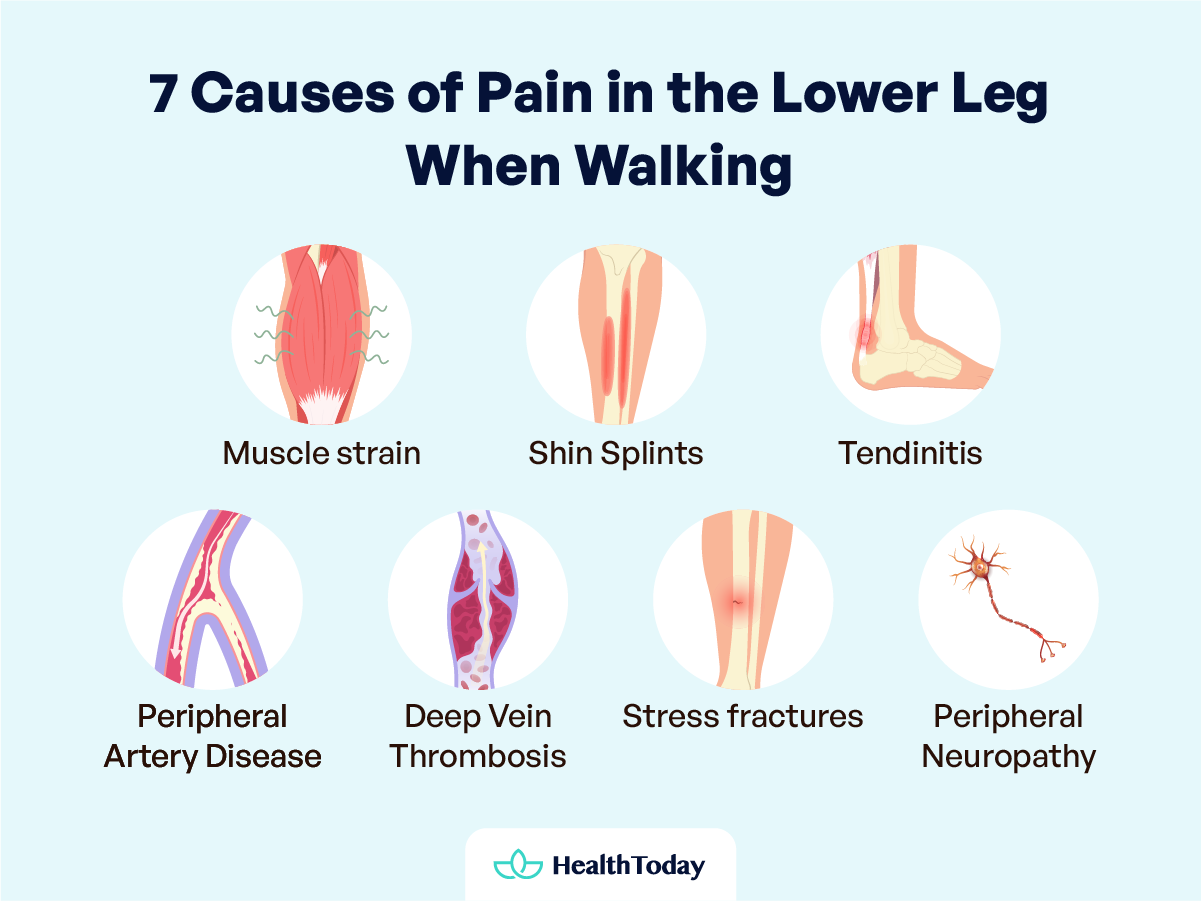
1. Muscle strain
Commonly called a pulled muscle, this condition often occurs when muscles are overworked or torn because of repetitive exercises (1). It’s an injury frequently seen among athletes and people who suddenly increase the intensity of their activity.
Depending on the severity of the strain, you might experience a sharp, stabbing pain or a dull, throbbing ache. The affected area may swell or feel tender to the touch. Additionally, any type of movement of the strained muscle can lead to discomfort (2). Other times, you might experience a cramping sensation.
But why the cramping sensation?
When a muscle is strained, tiny tears in the tissue trigger your body’s protective mechanism. This leads to inflammation, which causes the muscle to cramp up or spasm (3). If you continue doing repetitive exercises despite the strain, the constant stress can worsen the tears and lead to more frequent or intense muscle spasms.
2. Shin splints (Medial Tibial Stress Syndrome)
Shin splints refer to pain along the inner edge of your shinbone. People who participate in activities such as running or dancing, which involve repetitive stress on the legs, are more susceptible to this injury (4).
The prolonged pounding of the feet can lead to micro-tears within the muscles, resulting in pain and tenderness.
It can also be caused by (5):
- Flat feet or inflexible arches
- Worn-out or unsupportive shoes
- A sudden increase in running distance or intensity
- Body mass index above 30 kg/m2
The pain usually appears as a dull ache that worsens during or after exercising (6). You may also notice tenderness in the affected area.
3. Tendinitis
Tendons are the connective tissue that attaches muscles to bones. Inflammation of the tendons can cause pain and tenderness. Here are the common types of tendinitis:
Posterior Tibial Tendinitis
Posterior Tibial Tendinitis (PTT) often develops because of repetitive stress or overuse of the posterior tibial tendon. This strain can lead to inflammation and degeneration of the tendon, causing pain and instability in the ankle and foot. Flatfoot deformity is closely associated with PTT. However, the following conditions can also contribute to the condition (7):
- Tarsal coalition: An abnormal connection between bones in the foot, restricting movement and potentially leading to tendon strain (8).
- Inflammatory arthritis: Inflammation of the foot and ankle joints that weakens the tendon and surrounding structures (9).
- Charcot arthropathy: Nerve damage in the lower leg can lead to joint instability and deformity, increasing stress on the tendon (10).
- Neuromuscular disease: Muscle weakness and impaired coordination can disrupt normal foot mechanics, stressing the tendon (11).
- Traumatic disruption of midfoot (Lisfranc) ligaments: Injuries to the ligaments supporting the midfoot can destabilize the arch and overload the posterior tibial tendon (12).
Peroneal Tendinitis
This is a type of injury that causes inflammation of the tendons on the outer side of the ankle (13). It can be caused by the lack of stability in the ankle, leading to chronic or acute injury. The pain from this condition is focused mostly on the ankle and worsens with ankle movements.
Achilles Tendinitis
Injuries caused by overuse can lead to inflammation of the Achilles tendon—the band of tissue connecting the calf muscles to the heel bone. Runners are particularly prone to this condition because of the sudden increases in intense activity or repetitive strain on the tendon. Pain and stiffness along the tendon—especially in the morning or after exercise—are common symptoms.
Like muscle strain and shin splints, tendinitis often develops because of repetitive motion (14). Also, exercising with improper footwear can limit your flexibility and pull on the Achilles tendon, leading to irritation (15).

4. Peripheral Artery Disease (PAD)
PAD happens when arteries in the legs narrow due to plaque buildup in the artery walls. This restricts blood flow, resulting in pain, cramping, and leg fatigue. The pain usually improves with rest and worsens with activity like walking, resulting in claudication (16).
The condition is often caused by smoking, high blood pressure, high cholesterol, and diabetes. If left untreated, it can cause numbness, tingling, or weakness in your legs.
5. Deep Vein Thrombosis (DVT)
DVT is a serious condition in which a blood clot forms in a deep calf vein (17). Initially, it can occur without any symptoms, making it hard to detect until you start feeling pain in your lower legs.
It often results from one of the following (18, 19):
- Reduced mobility or inactivity
- Injured veins
- Chronic inflammatory diseases
- Obesity
- Pregnancy and hormonal changes
- Malignancy
- Genetic clotting disorders
The condition irritates the surrounding tissue and vein wall and leads to an inflammatory process that results in the formation of clots. When a blood clot obstructs blood flow through a vein in the leg, it leads to pressure buildup in the surrounding tissue. You’ll often recognize this as a feeling of tightness in the leg or fullness in the affected area.
In severe cases, large clots can restrict blood flow to the extent that it damages muscle tissue. Muscle damage can manifest as a dull, throbbing ache throbbing or a stabbing pain.
Other potential symptoms include (20):
- Swelling in one leg
- Redness or discolored skin over the affected area
- Warmth of the skin overlying the affected area
6. Stress fractures
While stress fractures may seem minor, they can be quite bothersome. Stress fractures are small cracks or fissures that develop in bones because of repetitive exercises, especially those with a high impact, such as running (21).
Stress fractures can affect parts of your body that help you carry your weight, like the shinbone, foot bones, or heel bone.
The condition is also caused by:
- A sudden increase in the duration or intensity of exercise
- Repetitive movement, such as running
- Improper footwear
- Nutrient deficiencies
- Improper training techniques
- Muscle alignment imbalances
Like most painful conditions, the ache worsens when you move or carry out daily tasks. However, it does improve with rest. You might also notice some swelling and tenderness of the bone over the injured area.
7. Peripheral Neuropathy (PN)
Peripheral Neuropathy (PN) is often the result of nerve damage to the peripheral nerves, which are located outside the brain and spinal cord (22). This condition can affect nerves throughout the body, including those in your legs and feet.
Uncontrolled diabetes (diabetic neuropathy) and autoimmune disorders like Lyme disease can cause PN (23, 24). In some cases, vitamin B12 deficiency and medications like chemotherapy drugs or certain antibiotics can lead to PN (25, 26, 27).
Overworking or tearing a muscle leads to muscle strain, causing pain, tenderness, and cramping.
Repetitive stress on the legs can result in shin splints, with pain experienced along the shinbone. Shin splints can also be linked to flat feet, worn-out shoes, or sudden changes in your exercise routine.
Inflammation of the tendons, called tendonitis, causes pain and tenderness in areas like the ankle. Repetitive motion and improper footwear are often to blame.
When there’s plaque buildup in your arteries, it can lead to Peripheral Artery Disease (PAD). PAD pain worsens with activity and improves with rest. The condition occurs from the effects of smoking, high blood pressure, high cholesterol, and diabetes.
A blood clot in the deep calf vein—Deep Vein Thrombosis (DVT)—can cause pain, tightness, and swelling. Reduced mobility and vein injury increase your chances of developing DVT.
Small cracks (stress fractures) in weight-bearing bones can develop from repetitive stress to the area. The pain worsens with activity and is often accompanied by swelling and tenderness.
Damage to nerves outside the brain and spinal cord leads to Peripheral Neuropathy. Diabetes, vitamin deficiencies, and certain medications can cause this as well.






Symptoms of different types of pain
Most lower leg pain originates from muscles or nerves in that region. The exact cause varies- however, recognizing the specific areas of your lower leg associated with certain conditions can help pinpoint the cause. Here are the symptoms of some common causes of lower leg pain corresponding with their locations.
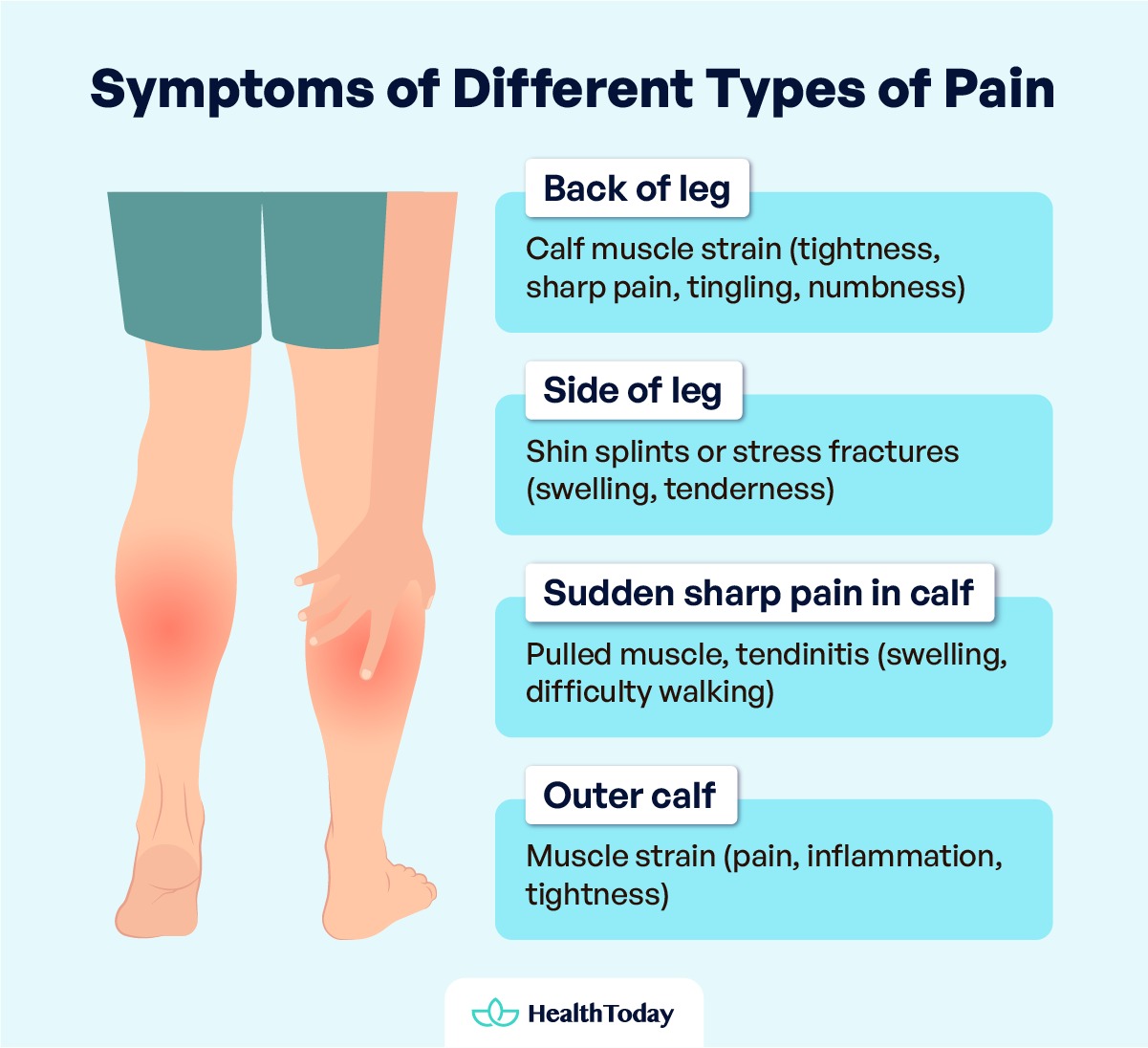

Pain in the back of the leg when walking
Pain in the back of your leg can be caused by a strain (28) in one of the calf muscles. A mild injury or tear in the muscle fibers is mainly responsible for the dull ache and tightness.
Here are other symptoms you may experience:
- Sharp or stabbing pain
- Tingling
- Numbness
- Weakness or difficulty moving your leg
The side of the leg hurts when walking
Common causes of pain in the side of your leg are shin splints, calf muscle strain, or stress fractures (29).
Calf muscle strain
You’ll likely experience this pain on the side and back of the lower leg.
Signs include:
- Pain, tightness, or tenderness in the calf muscle
- Pain that worsens with activity, like walking or stretching
- Bruising in more severe cases
Shin splints
Shin splints typically involve pain along the front of the shin bone, but they can also occasionally cause pain that radiates to the sides of the leg.
Signs to look out for include:
- Pain and tenderness along the inner edge of the shinbone
- Pain that worsens with activity, like walking, and improves with rest
- Possible mild swelling
Stress fractures
Stress fractures occur in the weight-bearing bones of the lower leg and foot (tibia, metatarsals, and fibula) (30). They cause pain in the front portion or sometimes on the side of the leg if the fracture is located on the outer side of the shin bone.
Common signs include:
- Localized pain and tenderness over the affected bone (shinbone, foot bones)
- Pain that worsens with activity and improves with rest
- Swelling and bruising around the affected area






Sudden pain in the calf muscle while walking
Experiencing a sudden, sharp pain in your calf can be alarming, often indicating a sudden pull or tear of the muscles or a tendon. This type of pain typically suggests calf muscle strain, muscle cramps, or tendinitis (31, 32, 33).
You might notice:
- Swelling
- Redness
- Tenderness
- Difficulty putting weight on your leg
In rare cases, this could be a sign of DVT. If you experience significant pain accompanied by swelling, redness, warmth, and difficulty walking, seek immediate medical attention.
Pain in the outer calf when walking
Pain on the outer side of your calf that develops while you’re walking could be a sign of muscle strain (34). In addition to pain, watch out for signs of inflammation and feelings of tightness.
If you have pain in the back of your leg, it could be a muscle strain. You may feel tightness, sharp pain, tingling, or numbness.
Pain on the side of your leg could be a sign of shin splints or stress fractures, often accompanied by swelling and tenderness.
A sudden, sharp pain in your calf might indicate a pulled muscle, tendonitis, or shin splints. It’s coupled with swelling and difficulty walking.
Treatment of lower leg pain when walking
Lower leg pain has various causes. For this reason, treatment will depend on the specific condition. Rest is often the first approach to relieving pain. But, if the condition is severe, you might have to stop the activity that caused the problem and take medication to ease inflammation.
Here are some common approaches:
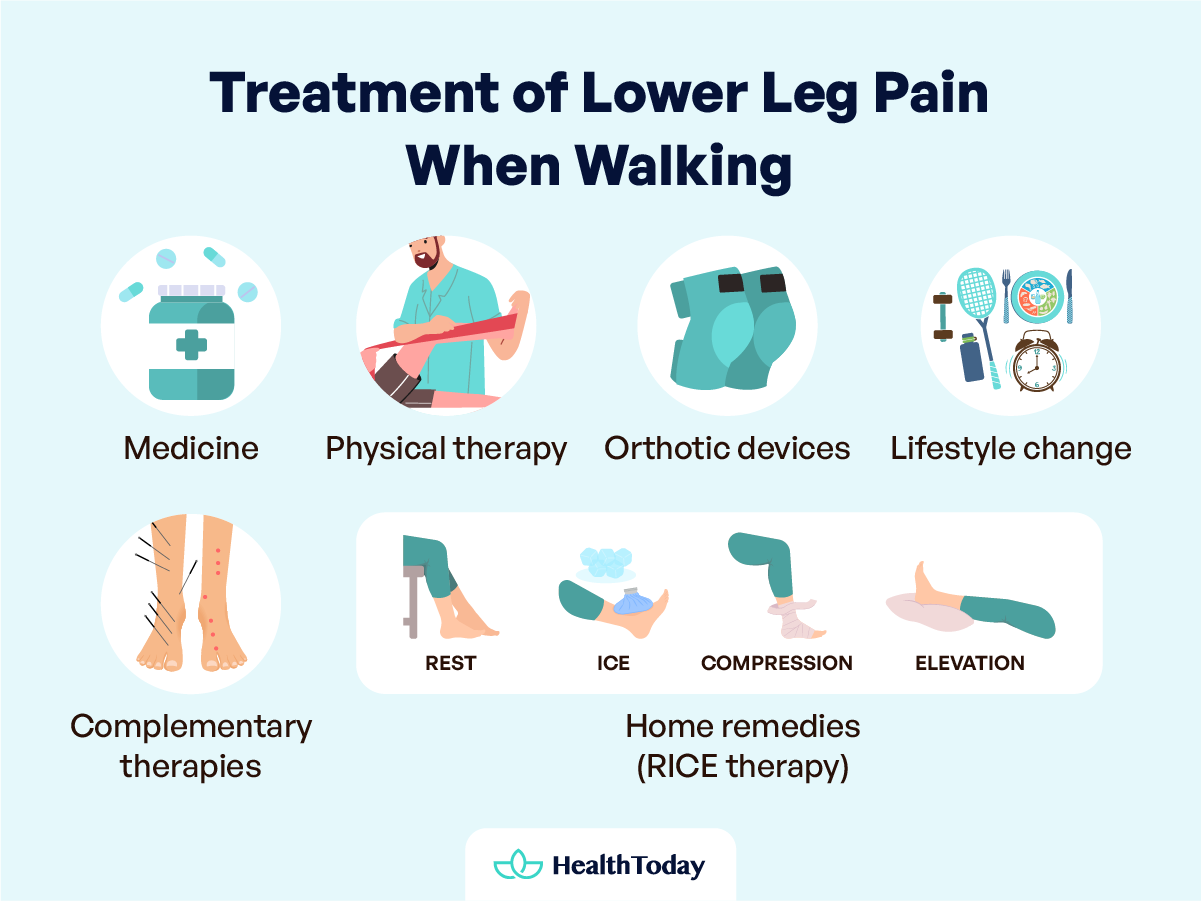

Treatment
Over-the-counter pain relievers
For many cases of musculoskeletal pain, like muscle strain, over-the-counter medication can help. These include nonsteroidal anti-inflammatory drugs (NSAIDs) like ibuprofen or acetaminophen (35). They can help manage pain and inflammation and allow you to move more comfortably while the injury is healing.
Prescription medications
Sometimes, your doctor may prescribe stronger medications, depending on the underlying cause of your condition.
Conditions requiring prescription drugs can include:
- PAD or DVT: If you have either of these conditions, you might be prescribed antiplatelet agents or anticoagulants to help prevent blood clots or improve blood flow (36, 37).
- Muscle strain/spasm: Muscle relaxants might be prescribed to ease muscle tightness and discomfort (38).
- Nerve pain: If your pain is related to nerve damage, like Peripheral Neuropathy, your practitioner might prescribe medications that specifically target nerve pain (39).
Physical therapy
Physical therapy can be a powerful tool for managing lower leg pain. It tackles the root causes of your discomfort, not just the symptoms.
Physical therapists can (40, 41, 42) do the following:
- Assess your posture, movement patterns, and muscle strength to identify underlying conditions or muscle imbalances contributing to your pain.
- Recommend targeted exercises that will strengthen the muscles that support your lower leg. This improvement in stability will help prevent further injury and alleviate stress on your joints.
- Gentle stretching exercises can improve flexibility and range of motion. Over time, movement will feel easier and less painful.
Orthotic devices
Orthotic devices, like shoe inserts, braces, or orthopedic footwear, provide support, stability, and alignment (43, 44). These tools help reduce strain on your legs, alleviate pain, and safely resume your previous activity.
Lifestyle modifications
The choices you make in your daily life can significantly impact the health of your leg. If you’re a smoker, kick the habit. Smoking restricts blood flow, which can result in PAD (45). If you’re carrying more pounds than recommended for your height, lose them and maintain a healthy weight through a balanced diet and regular, gentle exercise.
Complementary therapies
In addition to conventional treatment or physical therapy, some people find relief through complementary therapies (46).
Common ones include:
- Acupuncture: The insertion of thin needles into specific points stimulates nerves, releasing natural painkillers and promoting blood flow to the injured area (47).
- Chiropractic care: Manual adjustments of the spine and other joints restore proper alignment and improve joint function. This treatment can help relieve pain, reduce muscle spasms, and increase range of motion.
- Massage therapy: Different massage techniques can help relax muscles, reduce inflammation, promote better circulation, and break up scar tissue, leading to pain relief, increased flexibility, and improved healing.
- Herbal supplements: Certain herbs like turmeric and ginger have anti-inflammatory properties that reduce swelling and pain associated with musculoskeletal injuries (48, 49).
Home remedies
Did you know mild conditions—like muscle strain—can often be remedied at home? These techniques offer temporary relief and assist the healing process. However, they should not replace proper medical diagnosis and treatment for persistent pain or more severe injuries.
Here are some general remedies that might help to alleviate lower leg pain:
Rest
This is the golden rule recommended for most musculoskeletal pain, including lower leg pain. Minimizing activities that aggravate the condition allows the body to commence its natural healing processes. Resting decreases the metabolic demand on the affected tissues, reducing blood flow to the injured area (50).
Ice
Initially, it’s often recommended to apply ice packs wrapped in a thin towel to the affected area for 10 to 20 minutes, several times a day. The cold temperature can significantly help to reduce inflammation and pain in the first few hours after an injury occurs (51).
Elevation
Elevating your leg above your heart level reduces swelling and promotes a better return of blood to the heart. Propping your leg on pillows while resting or lying down can be beneficial when experiencing significant swelling.
Compression
When your clinician advises so, wearing compression socks or stockings can help minimize swelling and improve circulation (52).
Compression therapy is generally safe and effective for managing lower leg pain. However, it can cause serious complications like skin necrosis, nerve damage, or blood clots if misused or used with contraindications. More common side effects include discomfort, dry skin, and itching, which can be minimized with proper skin care as advised by your healthcare provider (53).
Over-the-counter pain relievers like ibuprofen can help with most routine cases of musculoskeletal pain. Stronger medications might sometimes be prescribed to treat blood clots, muscle spasms, or nerve pain.
Physical therapy can address the root cause of some conditions by improving posture, strength, and flexibility.
Orthotic devices like shoe inserts offer support and proper alignment. Lifestyle changes—quitting smoking and maintaining a healthy weight—can improve leg health.
In mild cases, relief can also be found through acupuncture or massage, and home remedies like rest, ice, elevation, and compression.






When to see a doctor
You’ve tried home remedies and over-the-counter medication, but your leg pain keeps persisting. Now what? Here are some signs it’s time to consult your healthcare provider.
Persistent severe pain
If your pain is severe, continues for more than a few days, or deteriorates over time, it’s best to see a doctor. Acute severe or persistent pain could signal a more serious underlying condition, like a stress fracture or even a blood clot (DVT).
Swelling or redness
Swelling, redness, or warmth around the affected area indicates inflammation and can also be the hallmark signs of an infection (54). This is particularly evident if the symptoms appear suddenly or worsen over time, especially if they are associated with a skin wound.
Numbness or weakness
Numbness, tingling, or weakness can be concerning. These symptoms might point to nerve compression, problems with your blood vessels, or neurological dysfunction (55).
Difficulty walking or loss of balance
If you’re having significant difficulty walking, even for short distances, particularly if you find it hard to stand or maintain your balance, don’t ignore it. This could indicate a more severe musculoskeletal injury or nerve damage.
If you have persistent, severe pain accompanied by swelling, redness, numbness, weakness, or difficulty walking, it is recommended to seek medical attention. Look out for signs of infection, such as fever, chills, or discharge from a skin wound. These could signal serious conditions like an infection, blood clot, fracture, or nerve damage.






When should I be concerned about lower leg pain?
While occasional leg pain might result from muscle strain or fatigue, persistent or severe pain should be evaluated immediately. If the pain is accompanied by swelling, redness, warmth, or wounds that don’t heal, it could be a sign of an infection or DVT.
Pale, blue, or cold skin could signal poor circulation and PAD.
Significant pain, numbness, or inability to bear weight might indicate nerve or blood vessel problems.
How do I know if my leg pain is vascular or muscular?
Muscular pain often presents as cramps, dull aches, or sharp soreness. The pain worsens with activity but improves with rest.
Vascular pain manifests as throbbing, tightness in the legs, changes in skin color, and cold sensations. The pain worsens when walking or standing for long periods and improves when you elevate your legs. This type of pain can be a sign of conditions like Peripheral Artery Disease (PAD).
What are the symptoms of poor circulation in the lower legs?
Signs of poor circulation include (56) any of the following:
– Painful cramps in the legs after an activity (like walking) and even rest
– Numbness, tingling, or weakness in the legs
– Coldness in the feet or lower legs
– Wounds that heal slowly
– Changes in skin color—pale or shiny
– Swelling in the feet, ankles, or legs
– Hair loss in the lower legs
How can I increase blood flow to my legs naturally?
If you struggle with sluggish, achy legs, there are simple and natural ways to boost circulation.
Regular physical activity is key. Aim for at least 35 minutes of exercise most days of the week (57).
You can wear compression stockings during the day to support the veins in your legs and improve circulation (58). The progressive compression design provides enhanced support at the calf, aiding muscle function. This helps promote efficient blood return from the lower leg, reducing fatigue and swelling.
Eat a balanced diet of fruits, vegetables, and whole grains to support the cells lining your blood vessels and prevent plaque buildup that obstructs blood flow (59).
If you are a smoker, quit it because it damages blood vessels and hinders blood flow (60).
What is the best vitamin for blood circulation in the legs?
B vitamins like B3 (niacin) improve circulation by lowering bad cholesterol and raising your level of good cholesterol, thus protecting your vessels from diseases that lead to blockages (61).
Vitamin B12 supports the production of red blood cells, making it easier for oxygen to be carried throughout the body (62).
Vitamin C protects the cells in the lining of your blood vessels. It helps them relax and allows more blood to pass through (63).
Vitamin E’s antioxidant properties help reduce inflammation and prevent blood clots, ensuring smooth blood flow to your legs (64, 65).
Summary
Lower leg pain can make it difficult to continue enjoying your exercise routine or training for an upcoming event. Some cases may result from minor issues like muscle strain or shin splints while others can be a symptom of more serious conditions like DVT or PAD.
Simple remedies like rest, applying ice, or elevating your leg can help to ease the pain. At first, it might be difficult to stop exercising, but following these suggestions will make it easier to return to the activities you love.
If you are experiencing severe or persistent pain, swelling, redness, numbness, or weakness, seek medical attention promptly. Early diagnosis allows for proper treatment, preventing complications and promoting faster healing.
Lower leg pain can have various causes! Have you experienced it? What helped you get back on your feet? Share your experiences and tips in the comments below. We can all learn from each other!










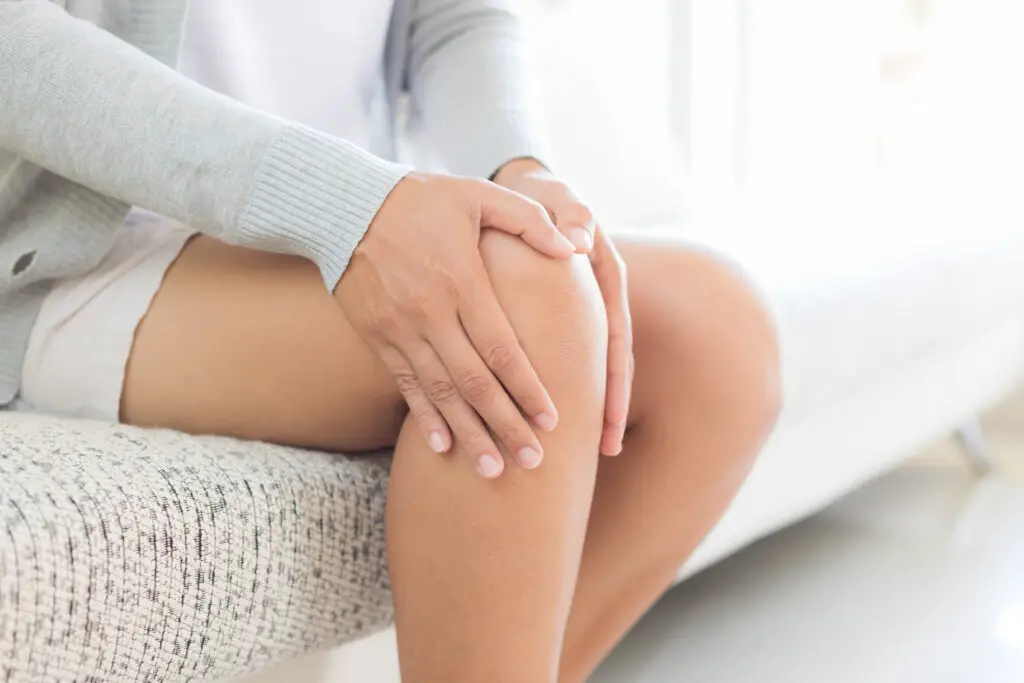


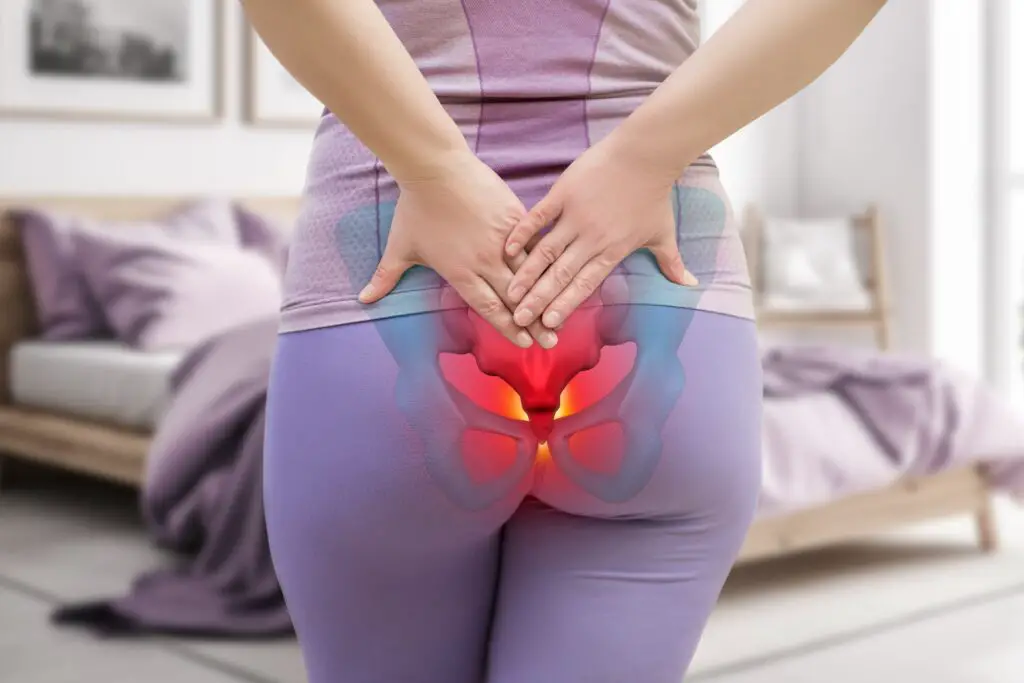


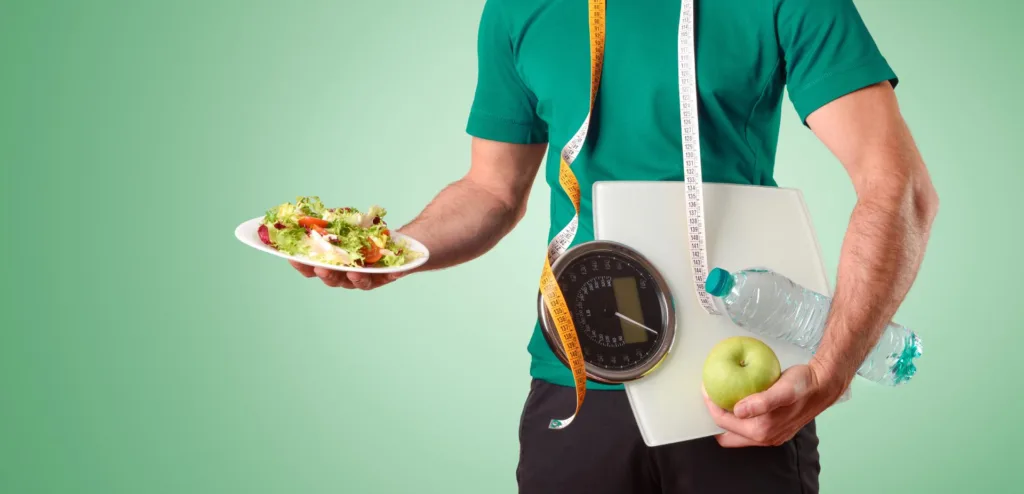
Comments
0